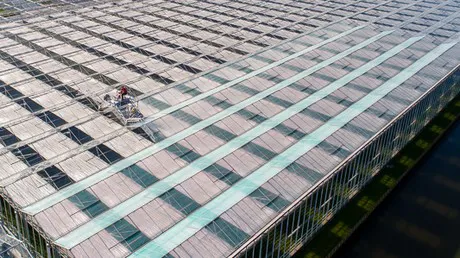All the sunlight's colours have an effect on a crop. The role of the light's green colour has long been underestimated; however, in recent years, the important effect of the colour green has become increasingly clear.

Leaves absorb the light and use it for photosynthesis, but they also partly reflect it. This reflection is highest for green light. As a result, the past conclusion was that this light colour was not all that important for the plant.
In recent years a great deal of research has been conducted that shows that this conclusion is not quite right. In fact, green light serves a wide range of functions for the plant.
First, the degree of reflection is not as high as originally thought. A single leaf does not absorb green light to the same extent as, for example, blue or red light, but taken across the entire crop, this barely makes any difference. This is because the reflected green light continues its path through the crop and ultimately for the most part is used for photosynthesis after all.
PAR Light
The different PAR (Photosynthetic Active Radiation) Light colours are not only important for photosynthesis, but also for controlling the plant's shape and development. It is precisely in this area that insights into the role of green light have grown considerably.
It appears that the ratio of blue and green light affects the plant's extension growth. Less green light reduces the plant's extension growth. Or in reverse: less blue stimulates extension growth. We make use of this phenomenon in our coatings. Rose growers throughout the world are currently using ReduFlex Blue to develop longer flower stems. This coating partly inhibits the transmission of the sunlight's blue colour through the greenhouse roof. This changes the green/blue ratio.
By contrast, ReduFlex Green – which partly inhibits the light's green colour – can be used to create plants that are compact.
Heating
Aside from its effect on the crop's shape, there are still other effects as well. Green light plays a role in the plants' tendency to grow towards the light. Furthermore, this light colour appears to promote resistance against diseases and pathogens in some crops.
Aside from photosynthesis and controlling the shape, the sunlight also heats up the crop. The thermal radiation is primarily responsible for this. Excessive heating is a key reason why plants grow to be (too) long.
In addition to reflecting part of the green light, ReduFlex Green also reflects part of the thermal heat. This combination can have an interesting effect for potted and bedding plants, where compactness is an important quality feature. The possible applications are currently still being investigated.
For more information
Mardenkro The Netherlands
Geerstraat 8
5111 PS Baarle-Nassau
The Netherlands
T: +31 (0)13 507 70 69
Email: sales@redusystems.com
www.redusystems.com
